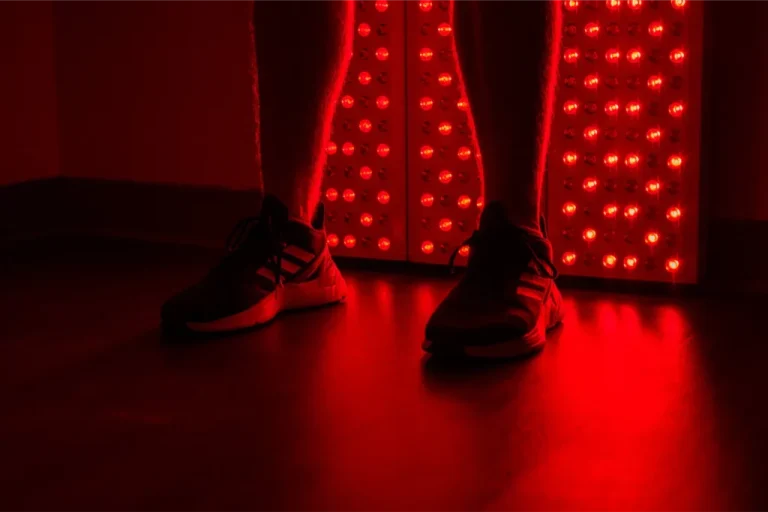Is It Bullshit: Red Light Therapy for Weight Loss?
When you’re trying to lose weight, there’s a bunch of stuff involved. You might have to change what you eat, get moving, and make healthier choices in your day-to-day life.
So, if someone tells you there’s a magic treatment that can melt your fat away, our advice is to maintain a healthy dose of skepticism, even if the hyped-up product seems to make sense scientifically.
What is Red Light Therapy?
RLT typically involves shining low-level wavelengths of red light near or in direct contact with the skin. FYI, the preferred terms among scientists are photobiomodulation(PBM) or low-level laser therapy (LLLT). Simply put, this fancy-sounding technology centers on the notion that RED and NIR (near-infrared) lights can soak into your skin and activate the body’s innate ability to heal itself.
From handheld gadgets to face masks and LED helmets, RLT devices come in many shapes and sizes. Usually applied to alleviate pain, inflammation, and stiffness, these gadgets vary by coverage area, power level, and wavelength combination, and some add electrical stimulation or magnetic fields to increase light absorption.
How does red light therapy kickstart weight loss?
What a million-dollar question.
In short, scientists and medical experts aren’t quite on the same page about how red light blasts away fat cells. That said, let’s first look at some recent studies that seem promising.
The most widely accepted mechanism of action1 is that adipocytes (also known as fat cells or lipocytes) shrink when exposed to red light. This occurs as light particles are absorbed into these cells, triggering an increase in cyclic adenosine monophosphate (cAMP) production, a type of cell messenger. This process activates cytoplasmic lipase, an enzyme that breaks down triglycerides into fatty acids and glycerol. These substances can then exit the cells through pores, leading to a reduction in the size of the fat cells.
Research that reports the efficacy of RLT in body contouring:
In 20202, researchers found that 2-weekly, 6-week sessions of low-level laser therapy resulted in a decrease of 0.8 inches (about 2 cm) in waist circumference. However, the experiment lacked a control group. Plus, 3 months after the study concluded, the participants’ weight and waist circumference showed no change from their initial measurements.
In a 20173 study, 28 obese women wore a waistband with near-infrared LEDs while walking on a treadmill. The LEDs emitted light at wavelengths of 630 nm, 830 nm, 880 nm, and 956 nm. Participants underwent the exercise three times a week for 12 weeks. The results showed significant reductions in abdominal fat and body weight.
Another study4 lasted 4 months with 49 obese women aged 20 to 40. They were split into two groups: one did exercise three times a week and got real LLLT treatment, while the other just exercised. Guess what? Both groups experienced varying degrees of weight loss, but the intervention group saw bigger improvements in fat mass, insulin, FGF21 (Fibroblast growth factor 21, “a hormone that regulates important metabolic pathways5“), and more.
You might have noticed this.
These studies generally require participants to engage in physical activity alongside LLLT, suggesting inadequate research on how effective LLLT is as a stand-alone treatment.
Meanwhile, as highlighted by some researchers, the majority of them tend to show results right after the treatment WITHOUT following up to see how things stick around in the long run (like 6 months). Also, as participants’ motivation for exercise tends to wane after treatment, reduced waist circumference and weight loss can bounce back.
Not many people talk about it, but there are side effects.
In 2016, scientists conducted a study where volunteers received 6 LLLT sessions at 650 nm on their abdomens, spaced every 2-3 days.
When researchers looked at how much fat thickness decreased on the treated side after correcting for changes on the untreated side, they found that in 8 out of 17 patients, LLLT surprisingly made the fat tissue thicker6. Two of them experienced severe side effects from the treatment: one developed ulcers around their appendix scar, and the other near their lower back.
Red light is doing its job at a molecular level?
Maybe. Marketers and non-medical staff love it.
Sounds plausible, huh?
In scientific research, however, it’s common and even encouraged to propose theoretical molecular mechanisms that sound plausible but lack clinical data support. As Jonathan Jarry M.Sc7. points out, scientific papers often explore these logical sequences of molecular events to explain phenomena or results.
And that’s just a sweet spot for the commercial world.
The choice of LEDs over lasers has been a strategic move for marketing. The FDA classifies LED power levels as safe, with minimal medical risks, leading to lighter regulations for LED devices compared to more hazardous laser technologies.
So, what’s the verdict?
I’ll just quote from this 2020 pilot study8:
“In order for weight loss maintenance to be successful, it should be maintained for 2 to 4 years and, to date, the only successful programs have been ones which consist of high physical activity, low-calorie/low-fat diets, and daily self-monitoring.”

- https://www.ncbi.nlm.nih.gov/pmc/articles/PMC5642174/ ↩︎
- https://link.springer.com/article/10.1007/s10103-019-02867-5 ↩︎
- https://www.ncbi.nlm.nih.gov/pmc/articles/PMC5684004/ ↩︎
- https://pubmed.ncbi.nlm.nih.gov/29473115/ ↩︎
- https://www.ncbi.nlm.nih.gov/pmc/articles/PMC6478891/ ↩︎
- https://www.ncbi.nlm.nih.gov/pmc/articles/PMC5288437/ ↩︎
- https://www.mcgill.ca/oss/article/medical-critical-thinking/hype-around-photobiomodulation ↩︎
- https://link.springer.com/article/10.1007/s10103-019-02867-5 ↩︎






